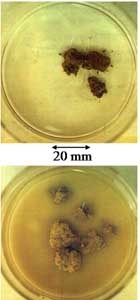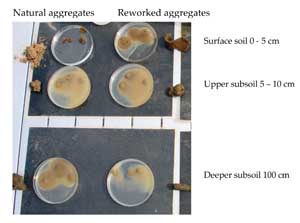Quick Reference Guide: Assessing aggregate stability
Download the PDF version of this document: Quick Reference Guide: Assessing aggregate stability (PDF 289KB).
To view the information PDF requires the use of a PDF reader. This can be installed for free from the Adobe website (external link).
 Figure 1. Example of soils that do not disperse (top) and that disperse (bottom). | When a fragment of soil is immersed in fresh water, there are four things that can happen:
You will need:
The soil should be sampled from the horizons of interest, particularly the top 0 - 10 cm, and the subsoil. Allow the soil to air-dry (this is very important and may take a couple of days). |
Using a shallow glass jar or dish, gently place three air-dry aggregates about the size of a green pea into 30 - 40 mm of rain or distilled water.
Watch the aggregates carefully for first few minutes to observe if slaking (refer Practical Note – Aggregate Stability) is to occur. Slaking will typically occur within the first hour.
Leave the samples for 20 hours before checking for dispersion, indicated by cloudiness or milkiness around the base of the aggregate. If dispersion is complete, a cloud will cover the bottom of the dish and the soil is categorised as ‘Highly Dispersive’.
| Highly Dispersive |
| Moderately Dispersive |
| Remould the soil (see below) and repeat |
| Dispersive after moist reworking |
| Non dispersive |
 Figure 2. Example of assessing aggregate stability on natural (left) and reworked (right) aggregates of soil from three horizons of a soil profile: surface soil, upper subsoil and deeper subsoil. Photograph:Mark Imhof. | Figure 2 shows the upper subsoil to be the most dispersive horizon of this soil profile, classified as ‘Highly Dispersive’. The shallow surface soil of this profile is ‘Non-Dispersive’, but when moist surface soil was reworked it became ‘Dispersive after Moist Reworking’. The deeper subsoil would be classified as ‘Moderately Dispersive’. |
What does this mean for my soil?
Highly Dispersive - Surface soils that are highly dispersive may suffer from severe crusting. Dispersive subsoils may have poor drainage and be prone to waterlogging. Dispersive soils are likely to respond to gypsum. A laboratory test will be valuable to determine how much gypsum to apply. Increasing the organic matter of the soil will assist in stabilising the soil also.
Moderately Dispersive – ‘Moderately Dispersive’ soils will have similar problems to ‘Highly Dispersive’ soils but to a lesser degree. These soils are likely to respond to gypsum.
Dispersive after Moist Reworking – Cultivation of the soil when it is moist will cause dispersion. Gypsum could be useful in promoting this soil to a ‘Non-Dispersive’ soil.
Non Dispersive – Excellent aggregate stability indicating the soil will not suffer from any significant soil structural problems. Appropriate management will help ensure structural stability into the future.
Reference:
Baxter NM & Williamson J (2001) Know Yours Soils – Assessing Yours Soils (Part 2). Department of Primary Industries, Bendigo Victoria. ISBN: 0 7311 4557 7


